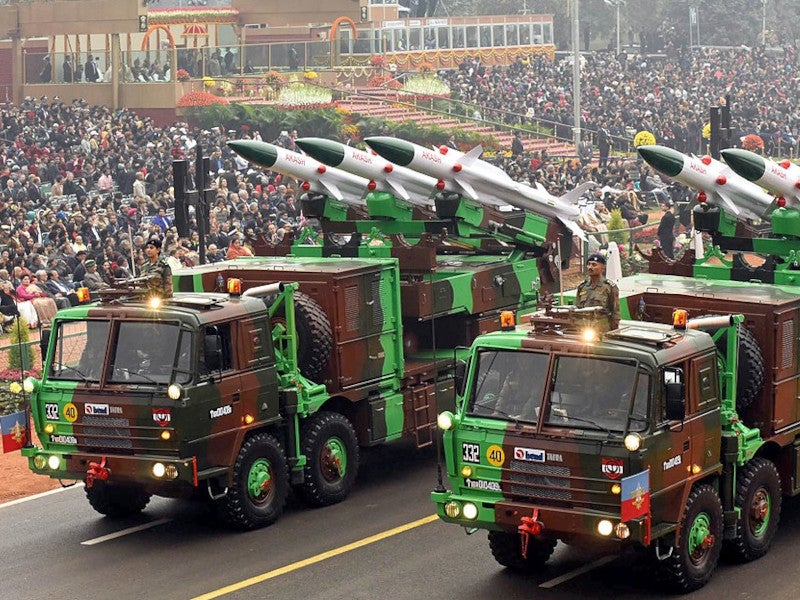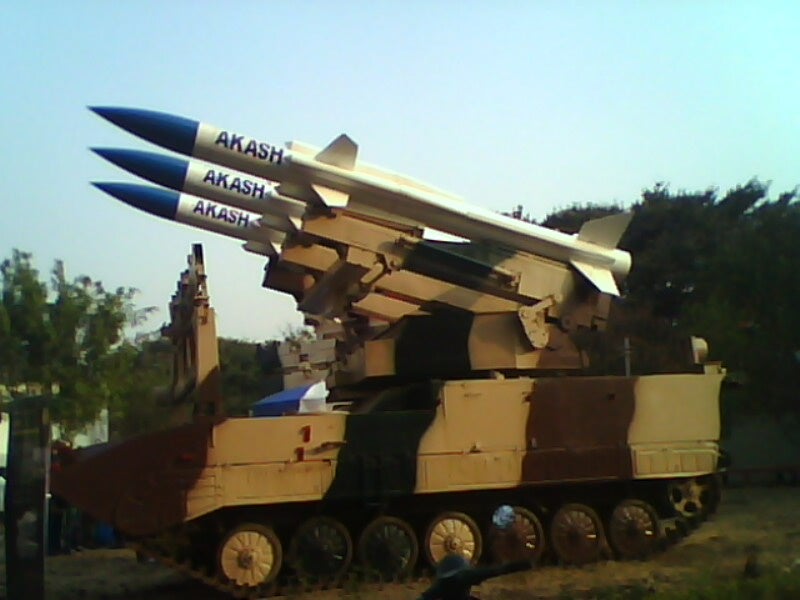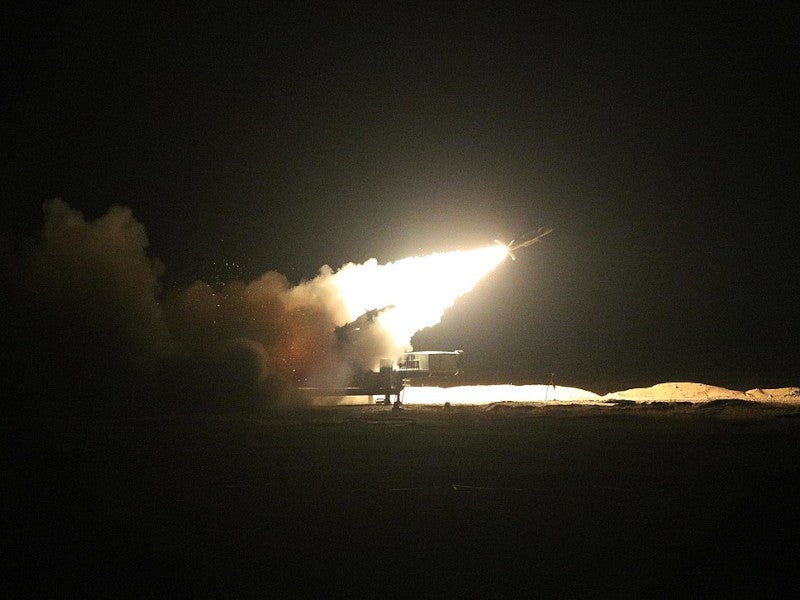The Akash (sky) is a mid-range surface-to-air missile (SAM) system built by India’s state-owned Defence Research and Development Organisation (DRDO).
The missile was developed under the Integrated Guided Missile Development Programme (IGMDP). The programme also involved the development of the Nag, Agni and Trishul missiles, as well as the Prithvi ballistic missile.
Two versions of the missile have been built for the Indian Air Force (IAF) and the Indian Army (IA). The first batch of the Akash missiles was inducted by the IA in May 2015. The first Akash missile was delivered to the IAF in March 2012. The missile was formally inducted into the IAF in July 2015.
Features of the mid-range surface-to-air missile system
The Akash SAM system can employ multiple air targets while operating in a fully autonomous mode.
The system features a launcher, a missile, a control centre, an integral mission guidance system, a multifunctional fire control radar, a system arming and explosion mechanism, a digital autopilot, C4I (command, control communication and intelligence) centres and supporting ground equipment.
The Group Control Centre (GCC) acts as the command and control headquarters for the surface-to-air missile system.
Each Akash battery includes four 3D passive electronically scanned array (PESA) radars and four self-propelled launchers with three missiles each, all of which are interconnected. It also has a battery-level radar known as Rajendra, as well as a battery control centre. It can track and attack multiple targets concurrently. A self-destructive device is also integrated into the missile.
The Akash system protects a moving procession of vehicles using an electronic counter-countermeasures (ECCM) system. Akash was also tested in a ballistic missile role and offers air defence missile coverage of 2,000km².
Flexible deployment and multitarget area defence capabilities of Akash
Akash missiles are designed to be launched from static or mobile platforms such as battle tanks and wheeled trucks, providing flexible deployment. It can handle multiple targets and destroy manoeuvring targets, including uncrewed aerial vehicles (UAVs), fighter aircraft, cruise missiles and missiles launched from helicopters.
The missile is capable of destroying aircraft within the range of 30km to 35km and at altitudes up to 18,000m. It renders multidirectional and multi-target area defence. It can carry conventional and nuclear warheads weighing up to 60kg.
The integration of a nuclear warhead allows the missile to destroy aircraft and warheads released from ballistic missiles. It can operate in all weather conditions.
Development timeline and tests
Development of the Akash missile began in 1983. The maiden trial firings were carried out in 1990. Developmental trials were conducted until March 1997. The missile was demonstrated for target interception capability against two live aerial targets in November 2005. A total of 16 trial firings were conducted by August 2006.
The test firing of the Akash for the IAF was carried out at the integrated test range (ITR) in Chandipur, Orissa in December 2007. The IAF rolled out its indigenous SAM system in 2008 upon completion of nine successful field trials.
The IAF successfully test-fired the Akash missile from the ITR in May 2012. The missile was successfully test-fired in ripple mode against a floating object launched by a pilotless target aircraft in May 2014.
The first Akash SAM production model for the Indian Army successfully destroyed a target in receding ting mode during two flight trials in February 2014.
The Indian Army conducted a test flight of the Akash missile against a mini unmanned fast-moving Banshee aerial vehicle at an altitude of 30m above sea level from the ITR in Chandipur in June 2014.
Development of an advanced version, Akash MK-II, began in June 2010. DRDO successfully test-fired the MK-II version in Balasore, Odisha coast, in May 2019.
Akash-NG (new generation) missile
DRDO is currently developing Akash-NG (new generation), the upgraded version of Akash SAM.
In July 2021, DRDO successfully tested the Akash-NG missile at the ITR in Chandipur. The missile successfully intercepted a high-speed uncrewed aerial target during the test.
The flight test confirmed the functioning of the entire weapon system, which includes a missile with a domestically developed radio frequency (RF) seeker, launcher, multi-function radar, and command, control and communication system.
Bharat Dynamics (BDL) delivered the initial radio RF seeker for the Akash-NG weapon system in August 2023. The seeker is a critical and technology-driven component employed in SAMs and air-to-air missiles to track targets during the final phase.
In January 2024, DRDO conducted another successful test on the AKASH-NG missile at the ITR in Chandipur. The missile intercepted and destroyed a high-speed uncrewed aerial target flying at a very low altitude during the flight test.
The successful flight test allows for user trials to commence on the missile system.
Rajendra radar details and propulsion of the DRDO’s missile system
The air force version of the Rajendra radar is capable of tracking 64 targets within a range of 60km in range, azimuth and height.
The army variation of the Akash uses the Rajendra radar, which can track 40 targets in range and azimuth with a tracking range of up to 100km.
The 3D central acquisition radar (CAR) is a long-range surveillance radar that warns the GCC by tracking 200 targets in track while scan (TWS) mode from a tracking range of 150km. It measures the azimuth, range and height of targets, and transmits to the GCC via communication links.
The GCC sends the target position information to the battery level radar (Rajendra).
The Akash is powered by a Ramjet-rocket propulsion system, which renders thrust for the missile to intercept the target at supersonic speed without any retardation.
Akash can fly at supersonic speeds ranging from Mach 2.8 to 3.5 and engage aerial targets up to a range of approximately 25km.
The kill probability of the missile is 88% and can be increased to 98.5% by launching the second missile after five seconds of launching the first.
Key players involved with India’s Akash (sky) SAM development project
The Akash SAM system was produced by Bharat Electronics (BDL), which serves as a nodal agency for Akash SAM production for the army.
Several DRDO labs are involved in the development of the Akash. The Defence Research & Development Laboratory (DRDL) is responsible for system integration and missile development. LRDE Bangalore manufactured the Rajendra radar. R&DE Pune developed the launcher.
The tracked vehicles were manufactured by CVRDE. ARDE built the nuclear warhead while HEMRL produced the propellants. Launcher systems were provided by Tata Power and Larsen & Toubro.
Orders and deliveries of the Akash SAM missiles
The IAF ordered 1,000 Akash missiles and the IA 2,000 missiles. The Indian Defence Acquisition Council (DAC) requested the army version of the Akash missile system in June 2010 in an order worth Rs125bn ($2.8bn).
BDL signed an Rs53.57bn ($752.89m) contract with the Ministry of Defence of India for the supply of seven squadrons of the Akash missile system for the IAF in September 2019.
The Indian Government approved the export of the Akash missile system in December 2020.
In March 2023, India’s Ministry of Defence (MoD) finalised contracts to acquire an upgraded Akash weapon system and 12 weapon locating radars (WLR Swathi – Plains) for the Indian Army, with a total expenditure exceeding Rs91bn ($1.09bn).






